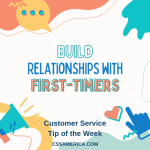The customer has a complaint, or they may have an important question about an order or their account. You may be talking to them in an emergency room, in the lobby of the government building, on the phone, or in a video conversation. And in many of these Moments of Truth, there is a high likelihood of the customer’s perceptions being affected based on how you handle the situation.
This is a Moment of Truth because of the topic, or the situation itself. The Topic could be the complaint, the question about an order or an account, an encounter with a new customer, or engagement with somebody who’s upset. The Situation could be a stressful emergency room visit, an encounter with a government agency, a wait time at the restaurant, or the arrival of the tech at the house 60 minutes after the scheduled time.
During these Moments of Truth, the employees have some control over the interaction. While it’s up to the customer to create their perception about the organization or the employee, this is where the employee needs to understand the critical nature of the topic, the critical nature of the situation.
Recognize the Critical Nature
The best employees in customer service recognize the critical nature of these situations and become agile. They have the ability to pivot – to flex their attitudes and actions in the moment.
The best can stop all other activities and focus on that individual. They can downshift, pulling their emotions back to keep the situation calm. They understand the frustration with wait times, and proactively communicate with the customer to decrease the perception of the wait and reduce the angst and anger. Staff have empathy for the customer and convey understanding of the situation back to that customer. The best staff have patience, speak with a specific intent for how to best communicate with that particular individual, and work through these situations with and for the customer. They recognize and pivot.
Identify the critical Topics and Situations that you encounter. Get in-tune with these situations, recognize when these critical moments are happening, and adjust your behaviors and words to deliver a great experience.
Signup for FREE Tips! Contact Us More Resources for You Visit Our Home Page
























